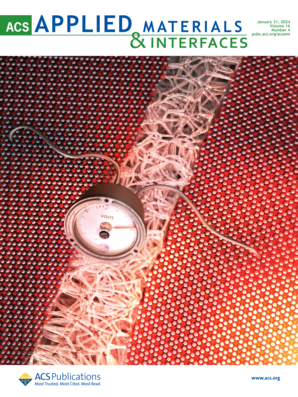Virucidal Efficacy of Laser-Generated Copper Nanoparticle Coatings against Model Coronavirus and Herpesvirus
IF 8.3
2区 材料科学
Q1 MATERIALS SCIENCE, MULTIDISCIPLINARY
引用次数: 0
Abstract
High-efficiency antiviral surfaces can be an effective means of fighting viral diseases, such as the recent COVID-19 pandemic. Copper and copper oxides, their nanoparticles (NPs) (CuNPs), and coatings are among the effective antiviral materials having internal and external biocidal effects on viruses. In this work, CuNP colloids were produced via femtosecond laser ablation of the metal target in water, a photophysical, cost-effective green synthesis alternative utilizing sodium citrate surfactant stabilizing the NPs. Raman spectroscopy and X-ray diffraction studies confirmed that the 32 nm mean size CuNPs are mixtures of mainly metallic copper and copper(I) oxide. Polyvinyl butyral was utilized as the binding agent for the CuNPs deposited via high-throughput spray-coating technology. The virucidal efficacy of such coatings containing Cu content ranging from 2.9 to 11.2 atom % was confirmed against animal-origin coronavirus containing ribonucleic acid, the agent of avian infectious bronchitis (IBV), and herpesvirus containing DNA, the agent of bovine herpesvirus (BoHV-1) infection. It was demonstrated that after a short time of exposure, the Cu NP-based coatings do not have a toxic effect on the cell cultures while demonstrating a negative effect on the biological activity of both model viruses that was confirmed by quantification of the viruses via the determination of tissue culture infectious dose (TCID50) virus titer and their viral nucleic acids via determination of threshold cycle (Ct) employing real-time polymerase chain reaction analysis. The assays showed that the decrease in TCID50 virus titer and increase in Ct values correlated with Cu content in Cu NP-based coatings for both investigated viruses. Contact with coatings decreased IBV and BoHV-1 numbers from 99.42% to 100.00% and from 98.65% to 99.96%, respectively. These findings suggest that CuNPs show inhibitory effects leading to the inactivation of viruses and their nuclei regardless of the presence of a viral envelope.

激光制备纳米铜涂层对新型冠状病毒和疱疹病毒的毒力研究
高效抗病毒表面可以成为对抗病毒性疾病的有效手段,例如最近的COVID-19大流行。铜和铜氧化物及其纳米粒子(NPs)和涂层是对病毒具有内外杀生物作用的有效抗病毒材料。在这项工作中,通过飞秒激光烧蚀水中的金属靶来制备CuNP胶体,这是一种利用柠檬酸钠表面活性剂稳定NPs的光物理、经济高效的绿色合成替代方案。拉曼光谱和x射线衍射研究证实,平均尺寸为32 nm的CuNPs主要是金属铜和铜(I)氧化物的混合物。以聚乙烯醇丁醛为粘合剂,采用高通量喷涂技术制备了聚乙烯醇丁醛树脂。对含有核糖核酸的动物源性冠状病毒(禽传染性支气管炎(IBV))和含有DNA的疱疹病毒(牛疱疹病毒(BoHV-1))具有抗病毒效果。结果表明,在短时间暴露后,铜np基涂层对细胞培养物没有毒性作用,但对两种模型病毒的生物活性有负面影响,这一点通过组织培养感染剂量(TCID50)病毒滴度的测定对病毒进行了量化,并通过实时聚合酶链式反应(pcr)测定了阈值周期(Ct),从而证实了这一点。结果表明,两种病毒的TCID50病毒滴度的降低和Ct值的升高都与Cu的含量有关。与涂层接触后,IBV和BoHV-1分别从99.42%降至100.00%和98.65%降至99.96%。这些发现表明,无论病毒包膜是否存在,CuNPs都表现出抑制作用,导致病毒及其细胞核失活。
本文章由计算机程序翻译,如有差异,请以英文原文为准。
求助全文
约1分钟内获得全文
求助全文
来源期刊

ACS Applied Materials & Interfaces
工程技术-材料科学:综合
CiteScore
16.00
自引率
6.30%
发文量
4978
审稿时长
1.8 months
期刊介绍:
ACS Applied Materials & Interfaces is a leading interdisciplinary journal that brings together chemists, engineers, physicists, and biologists to explore the development and utilization of newly-discovered materials and interfacial processes for specific applications. Our journal has experienced remarkable growth since its establishment in 2009, both in terms of the number of articles published and the impact of the research showcased. We are proud to foster a truly global community, with the majority of published articles originating from outside the United States, reflecting the rapid growth of applied research worldwide.
 求助内容:
求助内容: 应助结果提醒方式:
应助结果提醒方式:


